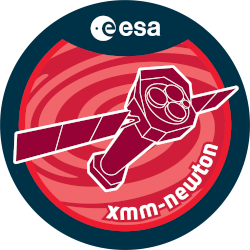

| Proposal ID | 090028 |
| Title | The Young Phoenix: incipient Cooling and Feedback in Abell 2667 |
| Download Data Associated to the proposal | https://nxsa.esac.esa.int/nxsa-sl/servlet/data-action-aio?obsno=0900280101 |
| DOI | https://doi.org/10.57780/esa-ffs98c5 |
| Principal Investigator, PI | Dr Paolo Tozzi |
| Abstract | We propose a deep observation of the CC cluster Abell 2667, where a recent studyhighlighted the presence of cold gas associated to an incipient cooling flow.The radio and the X-ray nuclear emission of the BCG depicts a situation similarto the Phoenix cluster, but with a ~20X lower nuclear power and 50X lower SFrate. Preliminary spectral analysis on a short XMM observation shows hints of amass flow of ~100 Msun/yr below 1 keV, consistent with the onset of a massivecooling flow. Our main scientific goal is to measure the mass deposition rate inthis young-Phoenix BCG making use of the full strength of XMM by (EPIC + RGSdata) to cover a new parameter range in the dot M-SFR plane, and provide a morecomplete picture of the cycle of baryons in the central regions of clusters. |
| Publications | No publications found for current proposal! |
| Instrument | EMOS1, EMOS2, EPN, OM, RGS1, RGS2 |
| Temporal Coverage | 2022-06-01T17:48:28Z/2022-12-25T18:06:15Z |
| Version | 20.09_20221024_1724 |
| Mission Description | The European Space Agencys (ESA) X-ray Multi-Mirror Mission (XMM-Newton) was launched by an Ariane 504 on December 10th 1999. XMM-Newton is ESAs second cornerstone of the Horizon 2000 Science Programme. It carries 3 high throughput X-ray telescopes with an unprecedented effective area, and an optical monitor, the first flown on a X-ray observatory. The large collecting area and ability to make long uninterrupted exposures provide highly sensitive observations. Since Earths atmosphere blocks out all X-rays, only a telescope in space can detect and study celestial X-ray sources. The XMM-Newton mission is helping scientists to solve a number of cosmic mysteries, ranging from the enigmatic black holes to the origins of the Universe itself. Observing time on XMM-Newton is being made available to the scientific community, applying for observational periods on a competitive basis. |
| Creator Contact | https://www.cosmos.esa.int/web/xmm-newton/xmm-newton-helpdesk |
| Date Published | 2024-01-26T00:00:00Z |
| Last Update | 2025-08-04 |
| Keywords | "Abell 2667", "mass deposition rate", "parameter range", "central region", "abell 2667", "mass flow", "XMM", "cold gas", "rgs data", "phoenix cluster", "phoenix '' bcg", "complete picture", "incipient cooling flow", "main scientific", "incipient cooling", "sfr plane", "preliminary spectral analysis", "xray nuclear emission", "massive cooling flow", "EPIC", "short xmm" |
| Publisher And Registrant | European Space Agency |
| Credit Guidelines | European Space Agency, Dr Paolo Tozzi, 2024, 'The Young Phoenix: incipient Cooling and Feedback in Abell 2667', 20.09_20221024_1724, European Space Agency, https://doi.org/10.57780/esa-ffs98c5 |